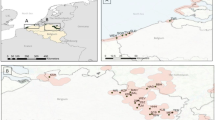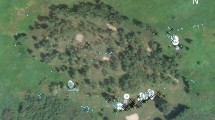Abstract
Habitat loss and fragmentation are the major causes of biodiversity loss, and, increasingly, habitat is fragmented by urbanization. Yet, the degree to which urbanization creates barriers to animal dispersal remains poorly understood. We used population genetic techniques to determine whether urbanization and/or natural landscape features are dispersal barriers to a butterfly, Atrytonopsis new species 1, throughout its range on coastal sand dunes that are increasingly threatened by development. Using AFLP markers that produced 89 polymorphic loci, we found significant population structure across the range of Atrytonopsis sp1. We found no indication that existing levels of urbanization were barriers to Atrytonopsis sp1 dispersal. Rather, two natural barriers, an ocean inlet and maritime forest, explained the genetic structure. Even in areas with long histories of urbanization, we found no significant isolation-by-distance relationship, and there was very low genetic differentiation between sampling locations. Consequently, conservation strategies for Atrytonopsis sp1, and potentially for other mobile insects that use open-structured habitats, should not focus explicitly on habitat corridors through urban areas, but rather should seek to preserve and restore as much habitat as possible across the butterfly’s range.



Similar content being viewed by others
References
Bolger DT, Suarez AV, Crooks KR, Morrison SA, Case TJ (2000) Arthropods in urban habitat fragments in southern California: area, age, and edge effects. Ecol Appl 10:230–1248
Bonin A, Ehrich D, Manel S (2007) Statistical analysis of amplified fragment length polymorphism data: a toolbox for molecular ecologists and evolutionists. Mol Ecol 16:3737–3758
Caughley G (1994) Directions in conservation biology. J Anim Ecol 63:215–244
Connor EF, Hafernik J, Levy J, Moore VL, Rickman JK (2002) Insect conservation in an urban biodiversity hotspot: the San Francisco Bay area. J Insect Conserv 6:247–259
Crossett KM, Culliton TJ, Wiley PC, Goodspeed TR (2004) Population trends along the coastal United States: 1980–2008. NOAA, Silver Spring
Culley TM, Sbita SJ, Wick A (2007) Population genetic effects of urban habitat fragmentation in the perennial herb Viola pubescens (Violaceae) using ISSR markers. Ann Bot 100:91–100
Daily GC, Ehrlich PR, Sanchez-Azofeifa GA (2001) Countryside biogeography: use of human-dominated habitats by the avifauna of southern Costa Rica. Ecol Appl 11:1–13
Daily GC, Ceballos G, Pacheco J, Suzan G, Sanchez-Azofeifa A (2003) Countryside biogeography of Neotropical mammals: conservation opportunities in agricultural landscapes of Costa Rica. Conserv Biol 17:1814–1826
DeSalle R, Amato G (2004) The expansion of conservation genetics. Nat Rev Genet 5:702–712
Desender K, Small E, Gaublomme E, Verdyck P (2005) Rural-urban gradients and the population genetic structure of woodland ground beetles. Conserv Genet 6:51–62
Dunn RR (2005) Modern insect extinctions, the neglected majority. Conserv Biol 109:1030–1036
Ehrenfeld JG (1990) Dynamics and processes of barrier island vegetation. Rev Aquat Sci 2:437–480
Ehrich D (2006) Aflpdat: a collection of r functions for convenient handling of AFLP data. Mol Ecol Notes 6:603–604
Epps CW, Palsboll PJ, Wehausen JD, Roderick GK, Ramey RR, McCullough DR (2005) Highways block gene flow and cause a rapid decline in genetic diversity of desert bighorn sheep. Ecol Lett 8:1029–1038
Excoffier L, Smouse PE, Quattro JM (1992) Analysis of molecular variance inferred from metric distances among DNA haplotypes: application to human mitochondrial DNA restriction data. Genetics 131:479–491
Excoffier L, Laval G, Schneider S (2005) Arlequin (version 3.0): an integrated software package for population genetics data analysis. Evol Bioinform Online 1:47–50
Faeth SH, Kane TC (1978) Urban biogeography—city parks as islands for Diptera and Coleoptera. Oecologia 32:127–133
Fahrig L (2003) Effects of habitat fragmentation on biodiversity. Annu Rev Ecol Evol Syst 34:487–515
Falush D, Stephens M, Pritchard JK (2003) Inference of population structure using multilocus genotype data: linked loci and correlated allele frequencies. Genetics 164:1567–1587
Falush D, Stephens M, Pritchard JK (2007) Inference of population structure using multilocus genotype data: dominant markers and null alleles. Mol Ecol Notes 7:574–578
Fisher JJ (1962) Geomorphic expression of former inlets along the outer banks of North Carolina. Ph.D. thesis, University of North Carolina—Chapel Hill
Goudet J (1995) FSTAT (Version 1.2): a computer program to calculate F-statistics. J Hered 86:485–486
Haddad NM (1999) Corridor use predicted from behaviors at habitat boundaries. Am Nat 153:215–227
Hall S (2004) Status survey for Atrytonopsis new species 1 in North Carolina. Report to US Fish and Wildlife Service, Raleigh, NC
Hanski I, Gilpin ME (1997) Metapopulation biology: ecology, genetics, and evolution. Academic Press, New York
Hitchings SP, Beebee TJC (1997) Genetic substructuring as a result of barriers to gene flow in urban Rana temporaria (common frog) populations: implications for biodiversity conservation. Heredity 79:117–127
Holderegger R, Wagner HH (2006) A brief guide to landscape genetics. Landsc Ecol 21:793–796
Horner-Devine MC, Daily GC, Ehrlich PR, Boggs CL (2003) Countryside biogeography of tropical butterflies. Conserv Biol 17:168–177
Hubisz MA, Falush D, Stephens M, Pritchard JK (2009) Inferring weak population structure with the assistance of sample group information. Mol Ecol Resour 9:1322–1332
Keller I, Largiadèr CR (2003) Recent habitat fragmentation caused by major roads leads to reduction of gene flow and loss of genetic variability in ground beetles. Proc Roy Soc B-Biol Sci 270:417–473
Keyghobadi N (2007) The genetic implications of habitat fragmentation for animals. Can J Zoolog 85:1049–1064
Keyghobadi N, Roland J, Strobeck C (1999) Influence of landscape on the population genetic structure of the alpine butterfly Parnassius smintheus (Papilionidae). Mol Ecol 8:1481–1495
Keyghobadi N, Roland J, Strobeck C (2005) Genetic differentiation and gene flow among populations of the alpine butterfly, Parnassius smintheus, vary with landscape connectivity. Mol Ecol 14:1897–1909
Koh LP, Sodhi NS (2004) Importance of reserves, fragments, and parks for butterfly conservation in a tropical urban landscape. Ecol Appl 14:1695–1708
Kuefler D, Hudgens B, Haddad NM, Morris WF, Thurgate N (2010) The conflicting role of matrix habitats as conduits and barriers for dispersal. Ecology 91:944–950
Leidner AK, Haddad NM (2006) Behavior of a rare butterfly in natural and urbanized areas: implications for dune conservation management. Report to North Carolina Sea Grant, Raleigh, NC
Lowe A, Harris S, Ashton P (2004) Ecological genetics: design, analysis, and application. Blackwell Publishing, Oxford
Lynch M, Milligan BG (1994) Analysis of population genetic structure with RAPD markers. Mol Ecol 3:91–99
Manel S, Schwartz MK, Luikart G, Taberlet P (2003) Landscape genetics: combining landscape ecology and population genetics. Trends Ecol Evol 18:189–197
Mantel N (1967) Detection of disease clustering and a generalized regression approach. Cancer Res 27:209–220
Marsh DM, Page RB, Hanlon TJ et al (2008) Effects of roads on patterns of genetic differentiation in red-backed salamanders, Plethodon cinereus. Conserv Genet 9:603–613
McFrederick QS, LeBuhn G (2006) Are urban parks refuges for bumble bees Bombus spp. (Hymenoptera: Apidae)? Bio Conserv 129:372–382
Mueller UG, Wolfenbarger LL (1999) AFLP genotyping and fingerprinting. Trends Ecol Evol 14:389–394
Noel S, Ouellet M, Galois P, Lapointe F (2007) Impact of urban fragmentation on the genetic structure of the eastern red-backed salamander. Conserv Genet 8:599–606
Pilkey OH Sr, Pilkey OH Jr, Turner R (1975) How to live with an island: a handbook to Bogue Banks, North Carolina. North Carolina Department of Natural and Economic Resources, Raleigh
Pritchard JK, Stephens M, Donnelly P (2000) Inference of population structure using multilocus genotype data. Genetics 155:945–959
Remington DL, Whetten RW, Liu BH, O’Malley DM (1999) Construction of an AFLP genetic map with nearly complete genome coverage in Pinus taeda. Theor Appl Genet 98:1279–1292
Ricketts TH, Daily GC, Ehrlich PR, Fay JP (2001) Countryside biogeography of moths in a fragmented landscape: biodiversity in native and agricultural habitats. Conserv Biol 15:378–388
Rickman JK, Connor EF (2003) The effect of urbanization on the quality of remnant habitats for leaf-mining Lepidoptera on Quercus agrifolia. Ecography 26:777–787
Ries L, Debinski DM (2001) Butterfly responses to habitat edges in the highly fragmented prairies of central Iowa. J Anim Ecol 70:840–852
Riley SPD, Pollinger JP, Sauvajot RM et al (2006) A southern California freeway is a physical and social barrier to gene flow in carnivores. Mol Ecol 15:1733–1741
Saunders DA, Hobbs RJ, Margules CR (1991) Biological consequences of ecosystem fragmentation—a review. Conserv Biol 5:18–32
Schtickzelle N, Joiris A, Van Dyck H, Baguette M (2007) Quantitative analysis of changes in movement behaviour within and outside habitat in a specialist butterfly. BMC Evol Biol 7:4
Sheck AL, Groot AT, Ward CM et al (2006) Genetics of sex pheromone blend differences between Heliothis virescens and Heliothis subflexa: a chromosome mapping approach. J Evol Biol 19:600–617
Smouse PE, Long JC, Sokal RR (1986) Multiple-regression and correlation extensions of the mantel test of matrix correspondence. Syst Zool 35:627–632
Takami Y, Koshio C, Ishii M, Fujii H, Hidaka T, Shimizu I (2004) Genetic diversity and structure of urban populations of Pieris butterflies assessed using amplified fragment length polymorphism. Mol Ecol 13:245–258
UNDP (2006) Demographic yearbook. United Nations, New York
Vandergast AG, Bohonak AJ, Weissman DB, Fisher RN (2007) Understanding the genetic effects of recent habitat fragmentation in the context of evolutionary history: phylogeography and landscape genetics of a southern California endemic Jerusalem cricket (Orthoptera: Stenopelmatidae: Stenopelmatus). Mol Ecol 16:977–992
Vekemans X, Beauwens T, Lemaire M, Roldán-Ruiz I (2002) Data from amplified fragment length polymorphism (AFLP) markers show indication of size homoplasy and of a relationship between degree of homoplasy and fragment size. Mol Ecol 11:139–151
Vos P, Hogers R, Bleeker M et al (1995) AFLP—a new technique for DNA-fingerprinting. Nucleic Acids Res 23:4407–4414
Wood BC, Pullin AS (2002) Persistence of species in a fragmented urban landscape: the importance of dispersal ability and habitat availability for grassland butterflies. Biodiv Conserv 11:1451–1468
Zhang DX (2004) Lepidopteran microsatellite DNA: redundant but promising. Trends Ecol Evol 19:507–509
Zhivotovsky LA (1999) Estimating population structure in diploids with multilocus dominant DNA markers. Mol Ecol 8:907–913
Zollner PA, Lima SL (1999) Search strategies for landscape-level interpatch movements. Ecology 80:1019–1030
Acknowledgments
This research was funded by grants from the National Park Service, North Carolina Sea Grant, the U.S. Fish and Wildlife Service, and the Xerces Society for Invertebrate Conservation. Steve Hall’s initial research on the status of Atrytonopsis sp1 provided an important base for our research. Caitlin Gille and Carla Hales and helped enormously with field work and Fred Gould and Stephanie Lorick provided invaluable access to lab space and assistance with lab work. Randy Newman, Sam Bland, and David Rabon provided assistance with the coordination of logistics. Fred Gould, George Hess, and Rob Dunn provided valuable comments on earlier drafts of this manuscript. Special thanks to North Carolina State Parks and the local town governments and private landowners for access to many sites.
Author information
Authors and Affiliations
Corresponding author
Electronic supplementary material
Below is the link to the electronic supplementary material.
Rights and permissions
About this article
Cite this article
Leidner, A.K., Haddad, N.M. Natural, not urban, barriers define population structure for a coastal endemic butterfly. Conserv Genet 11, 2311–2320 (2010). https://doi.org/10.1007/s10592-010-0117-5
Received:
Accepted:
Published:
Issue Date:
DOI: https://doi.org/10.1007/s10592-010-0117-5




